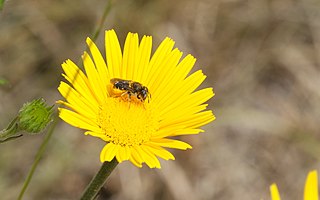
Sphecodes albilabris is a solitary parasitic bee that is endemic to Central and Western Europe. It also occurs in North Africa and is thought to have been introduced to the United States and Australia by accident.

Osmia cornuta, the European orchard bee, is a species of bee in the genus Osmia.

Andrena hattorfiana is a species of mining bees belonging to the family Andrenidae subfamily Andreninae.

Anthidium oblongatum, the oblong woolcarder bee, is a species of bee in the family Megachilidae, the leaf-cutter, carder, or mason bees.

The Clark's miner bee is a species of miner bee in the family Andrenidae. Other common names include Clark's andrena and Clarke's mining bee. It is found in Europe and Northern Asia and North America.

Andrena bicolor, or Gwynne's mining bee, is a common and widespread Western Palearctic mining bee which is found over most of Europe as well as North Africa and the Middle East and which reaches eastwards into Siberia.

Hylaeus communis is a Palearctic species of solitary bee.

Osmia aurulenta is a Palearctic species of mason bee.

Tetralonia malvae, also known as the Mallow longhorn, is a species of insect belonging to the family Apidae. The bee takes pollen from oligolectic sources on the mallow family (Malvaceae).

Bombus semenoviellus is a species of insect belonging to the family Apidae.

Anthophora bimaculata is a species of bees.
Hoplitis mocsaryi is a species of bees in the genus Hoplitis.
Coelioxys polycentris is a species of leaf-cutting cuckoo bee native to Europe and the Near East.

Pseudoanthidium tenellum is a species of bee in the family Megachilidae.

Osmia spinulosa, also known as the spined mason bee, is a species of bees within the genus Osmia.

Melecta luctuosa, also known as square-spotted mourning bee, is a species of bee within the family Apidae.

Tetraloniella dentata is a species of bees within the genus Tetraloniella.

Trachusa byssina is a species of bees within the genus Trachusa.

Bombus mesomelas is a species of bumblebees.

Sichel's bumblebee is a species of bumblebee.


















